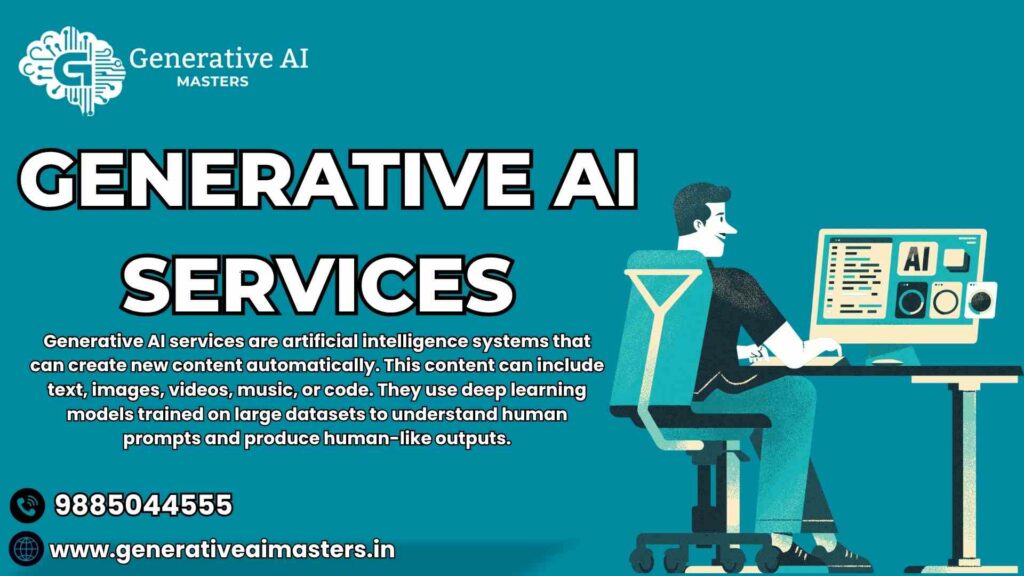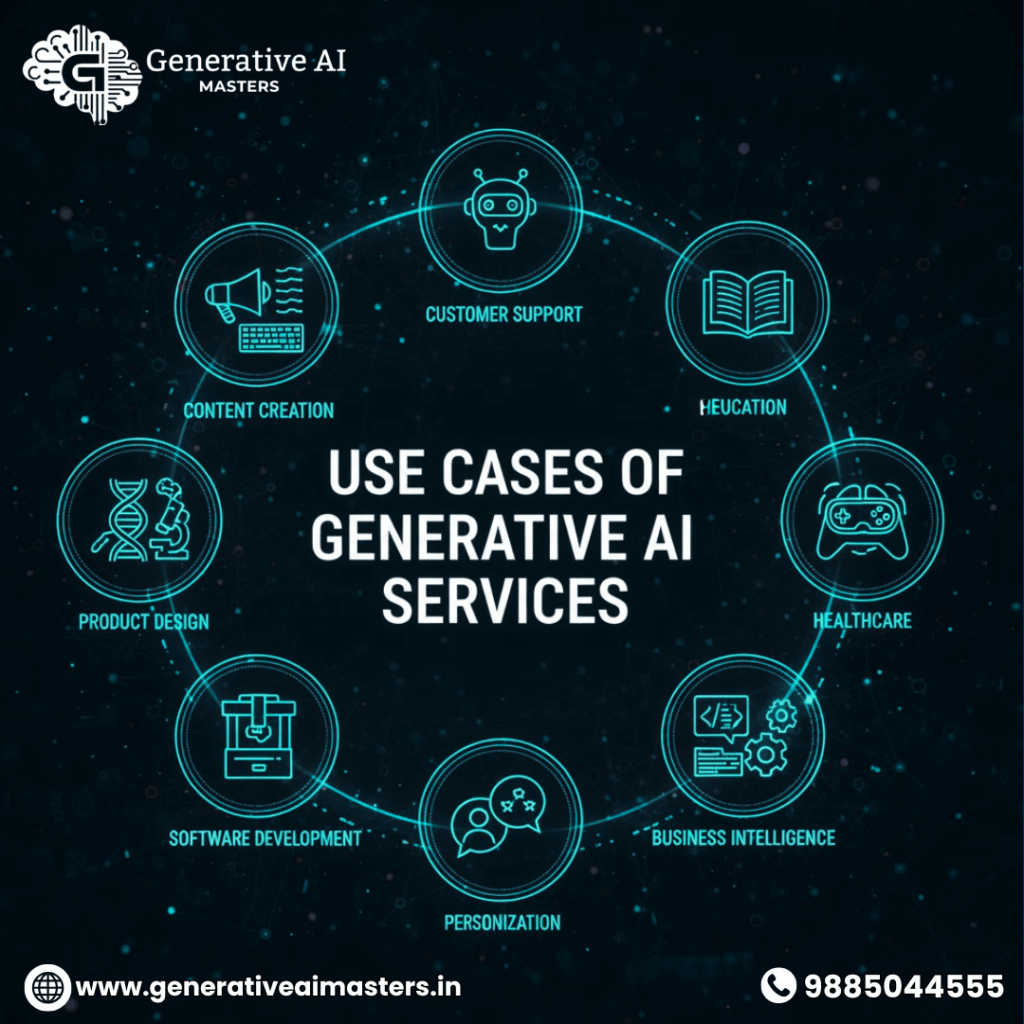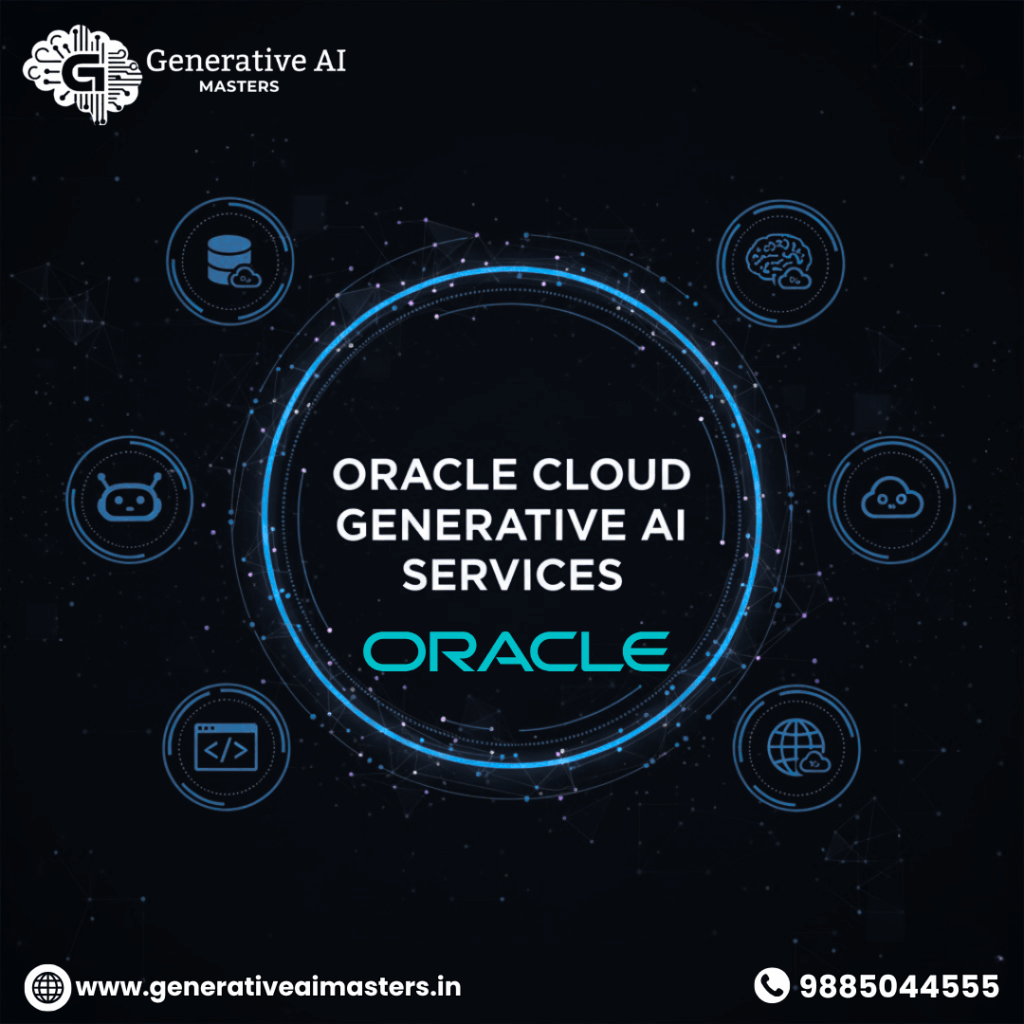Generative AI Services - for Business Growth

What are Generative AI Services?
Generative AI services are systems that create new content—such as text, images, audio, or code—from user prompts.
They leverage large language models (LLMs), diffusion models, or transformer architectures to generate outputs like articles, product descriptions, illustrations, or chat responses.
Common examples include GPT (for text), DALL·E or Stable Diffusion (for images), and generative code assistants.
These services are used for content creation, design, automation, chatbot responses, and creative workflows.
Types of Generative AI Services
Generative AI services come in many forms. Below are the main types based on what kind of content they create and how they work.
1. Text Generation Services
These services generate written content such as blogs, articles, emails, captions, and even books.
They use language models like GPT-4, GPT-5, or Claude to understand human language and write naturally.
Examples
- ChatGPT, Jasper AI, Copy.ai, Writesonic
- AI email writers and chatbot assistants
Use: Ideal for content creators, marketers, and writers who want to produce text faster.
2. Image Generation Services
These tools create realistic or artistic images based on text prompts.
You just type what you want to see, and the AI draws or designs it for you.
Examples
- DALL·E, Midjourney, Stable Diffusion, Adobe Firefly
Use: Used by designers, advertisers, and artists to create visuals, logos, or concept art.
3. Video Generation Services
Video generation AI can create or edit videos automatically from text or audio input.
Some tools can even create talking avatars or animations based on a script.
Examples
- Synthesia, Runway ML, Pika Labs, HeyGen
Use: Perfect for marketing, explainer videos, training content, or social media reels.
4. Audio and Music Generation Services
AI can also compose music, generate voiceovers, or clone voices.
These services help musicians, podcasters, and video editors to create custom soundtracks or narrations.
Examples
- AIVA, Soundraw, ElevenLabs, Voicemod
Use: Used in background music, audiobooks, advertisements, and dubbing.
5. Code Generation Services
Developers use generative AI to write or debug code automatically.
These tools understand programming languages and suggest optimized code snippets.
Examples
- GitHub Copilot, Amazon CodeWhisperer, Tabnine
Use: Helps developers write code faster, fix bugs, and improve productivity.
6. Design and 3D Model Generation
Generative AI services can design products, rooms, and 3D models automatically.
They are used in architecture, fashion, gaming, and product design.
Examples
- Runway ML, NVIDIA Omniverse, Fotor AI
Use: Useful for creating realistic prototypes and virtual environments.
7. Data and Document Generation Services
Some AI tools generate structured data, reports, summaries, or documents.
They analyze raw data and turn it into readable text or visual reports.
Examples
- ChatGPT for data summaries, Notion AI, Excel Copilot
Use: Business analytics, report generation, and data storytelling.
Use Cases of Generative AI Services


1. Content Creation and Marketing
Businesses use AI to create blog posts, ad copies, product descriptions, and social media posts.
This saves hours of manual work and keeps marketing consistent.
Example
An eCommerce brand uses Jasper AI to write 500 product descriptions in one day.
2. Customer Support and Chatbots
AI chatbots handle customer questions in real time.
They can understand language, respond politely, and even give personalized solutions.
Example
Companies integrate ChatGPT-based bots into websites for 24/7 customer service.
3. Education and Learning
Teachers and students use AI to generate notes, quizzes, and learning materials.
AI tutors can explain difficult topics in simple language.
Example
An online school uses AI to prepare lesson summaries for every class.
4. Healthcare and Research
In medicine, generative AI helps create synthetic medical data, summarize patient records, and even design new drugs.
Example
Pharmaceutical companies use AI to generate possible drug molecules before lab testing.
5. Entertainment and Gaming
Game studios use generative AI to build stories, characters, and 3D worlds faster.
Filmmakers use AI for editing and script writing.
Example
A gaming company uses AI to design new characters and voice lines.
6. Product Design and Prototyping
Designers use AI to create early models, design variations, and packaging ideas.
This reduces time and improves creativity.
Example
A furniture brand uses AI to generate 3D room layouts for customers.
7. Software Development and Automation
AI coding tools help developers build apps quickly by writing functions or fixing errors automatically.
They also generate test cases and documentation.
Example
A startup uses GitHub Copilot to build MVPs in half the time.
8. Personalization and Recommendation Systems
Generative AI can create personalized messages, music playlists, or product suggestions.
It learns from user preferences to make every experience unique.
Example
Streaming platforms use AI to generate custom recommendations for every user.
9. Translation and Localization
AI can translate content into multiple languages instantly while keeping context accurate.
This is helpful for global businesses and creators.
Example
A YouTuber uses AI to translate videos into 10 languages automatically.
10. Business Intelligence and Reporting
Companies use generative AI to summarize reports, write insights, and visualize data.
It helps executives make quick, data-driven decisions.
Example
A sales team uses AI to create weekly reports directly from CRM data.
Benefits of Using Generative AI Services
- Saves time and cost
- Improves creativity and content quality
- Reduces repetitive manual work
- Increases business productivity
- Offers 24/7 automation support
Top Free Generative AI Services in 2025
Below are the best and most popular free generative AI services available in 2025, categorized by their purpose.
1. Free AI Text Generation Tools
These tools generate text like articles, blogs, captions, product descriptions, or summaries.
Popular Free Text AI Services
- ChatGPT (Free Plan – GPT-3.5)
- Website: https://chat.openai.com
- Can write essays, blogs, and creative content easily.
- GPT-4 features are paid, but GPT-3.5 is free and powerful.
- Google Gemini Free
- Website: https://gemini.google.com
- Google’s AI assistant that helps generate answers, summaries, and creative ideas.
- ai (Free Plan)
- Great for marketing content and social media captions.
- Writesonic Free Plan
- Offers limited credits every month to write blogs or ad copy.
2. Free AI Image Generation Tools
These AI tools create images, artwork, or designs from text prompts.
Popular Free Image AI Services
- DALL·E (via ChatGPT Free)
- Generates creative illustrations directly inside ChatGPT.
- Easy to use and produces clean results.
- Bing Image Creator (Microsoft Designer)
- Free access to DALL·E 3 image generation through Bing or Microsoft Edge.
- High-quality, realistic images with text-to-image prompts.
- Stable Diffusion Online
- Website: https://stablediffusionweb.com
- 100% free image generator with custom styles.
- ai (Free Credits)
- Generates beautiful AI art, 3D concepts, and game assets.
3. Free AI Video Generation Tools
These platforms create short videos, avatars, or animations using AI.
Top Free AI Video Generators
- Pika Labs (Free Beta)
- Website: https://pika.art
- Turns text prompts into realistic videos automatically.
- Runway ML (Free Trial)
- AI for editing and generating short video clips.
- Synthesia Free Demo
- Creates talking avatar videos from your text.
- HeyGen Free Plan
- Limited free minutes to generate videos using AI avatars.
4. Free AI Audio & Voice Generation Tools
AI can now clone voices, generate speech, or even make background music.
Best Free Audio AI Tools
- ElevenLabs Free
- High-quality voice generation and cloning tool.
- Offers free monthly voice credits.
- Soundraw Free Trial
- AI music composer for video creators.
- Voicemod Free Plan
- Converts your voice in real-time for gaming or streaming.
- ai Creates royalty-free background music automatically.
5. Free AI Code Generation Tools
Developers can use AI tools to generate or debug code automatically.
Top Free AI Coding Tools
- GitHub Copilot Free (for Students)
- AI coding assistant integrated with Visual Studio Code.
- Codeium (Free for All)
- Supports 70+ programming languages.
- Great alternative to Copilot for personal use.
- Replit Ghostwriter Free Tier
- Online code editor with built-in AI completion.
- OpenAI’s GPT-3.5 in ChatGPT
- Can generate, explain, or fix code snippets.
6. Free AI Design and Presentation Tools
These tools help you design slides, social posts, and creative assets.
Popular Free AI Design Tools
- Canva Magic Studio
- AI tools for design, presentation, and text-to-image conversion.
- Free version includes many smart features.
- Microsoft Designer (Free Beta)
- Automatically creates social media posts and ad designs.
- Fotor AI Art Generator
- Free credits to generate artwork from text.
- Tome App (Free Tier)
- Generates presentations and storytelling slides using AI.
Tips to Use Free Generative AI Services Effectively
- Be specific with prompts.
Example: Instead of “make a photo,” say “create a futuristic city with neon lights at night.” - Use available free credits wisely.
Most free plans reset every month. - Experiment with multiple tools.
Combine text, image, and video generators for better results. - Always review AI content.
AI can make mistakes; check accuracy before publishing. - Upgrade when needed.
If you need high-quality output or commercial rights, consider premium versions.
Why Use Free Generative AI Services?
Free generative AI tools are a great option if you:
- Want to learn AI without spending money
- Need basic creative support for writing, design, or coding
- Want to test AI features before buying a premium plan
- Work on personal projects, social media, or small startups
Many free AI services offer strong features — some even close to premium ones.
Building Generative AI Services (2025 Step-by-Step Guide)
Key Components of a Generative AI Service
Before building your own service, it’s important to understand what it includes:
- Data – Training data such as text, images, or audio that helps the model learn.
- Model – The AI brain (like GPT, Diffusion, or Transformer models).
- Infrastructure – Cloud servers, GPUs, and APIs that run the AI system.
- Interface – The user-facing platform (like a website, chatbot, or app).
- Security & Ethics – Systems to prevent bias, fake content, or misuse.
Together, these elements form the structure of any generative AI service.
Collect and Prepare Data
Data is the foundation of any generative AI system.
Collect large, high-quality, and diverse datasets that match your goal.
Example datasets
- For text: open-source text corpora like Wikipedia or Common Crawl
- For images: LAION-5B dataset
- For code: GitHub repositories
- For music/audio: Free sound or open-music datasets
Then, clean and preprocess the data — remove errors, duplicates, and irrelevant content.
Select or Build the AI Model
You can either use a pre-trained model (faster and cheaper) or train your own (more control).
Popular pre-trained models (open source):
- Text: GPT-Neo, LLaMA 3, Mistral
- Image: Stable Diffusion, DreamBooth
- Video: Pika Labs, ModelScope
- Audio: MusicLM, Bark
- Code: StarCoder, Code LLaMA
For most startups, fine-tuning a pre-trained model is enough.
It means you take an existing AI model and train it a little more with your own data to make it specialized.
Build the Infrastructure
Once your model is ready, you need to host and deploy it.
Main options
- Cloud Platforms: AWS, Google Cloud, Azure, or Hugging Face Hub
- APIs: Use OpenAI, Anthropic, or Stability AI APIs
- Containers: Use Docker or Kubernetes for scaling
Make sure your system has enough GPU or TPU power — generative AI models need heavy computation.
Develop the User Interface
A good user experience is key.
Create a simple, attractive, and fast interface where users can interact with your AI.
Examples
- A web app where users enter text prompts
- A mobile app that generates images or music
- A chat interface like ChatGPT
You can build the frontend using React, Vue, or Flutter and connect it to your backend via REST or GraphQL APIs.
Add Security, Privacy, and Content Filters
Generative AI can sometimes produce false or unsafe content.
To protect users and your brand:
- Add content filters for violence, hate, or adult material
- Use user data encryption for privacy
- Add a moderation system to review generated outputs
Ethical and safe AI design builds trust and compliance with regulations like GDPR and AI Act 2025.
Test, Improve, and Launch
Before launching
- Test with real users
- Measure response quality, speed, and accuracy
- Collect feedback
- Retrain or fine-tune the model for improvement
After testing, deploy your AI on a scalable cloud server and connect analytics tools to monitor performance.
Key Capabilities of Generative AI Services (2025 Guide)
1. Text Generation and Natural Language Processing (NLP)
One of the most powerful capabilities of generative AI is text generation.
These AI systems can write human-like text in different styles and tones — essays, blogs, emails, social media posts, scripts, and much more.
How it works
Language models like GPT-5 or Claude learn grammar, tone, and structure from massive text datasets. They then predict and generate meaningful sentences based on prompts.
Example use cases
- Writing blog articles or product descriptions
- Drafting marketing emails or ads
- Creating chatbot responses
- Summarizing documents or reports
Popular tools: ChatGPT, Jasper AI, Copy.ai, Writesonic
2. Image and Visual Content Generation
Generative AI can also create images, graphics, or digital art from text prompts.
These AI models use diffusion and transformer-based architectures to understand text descriptions and turn them into visuals.
Example
Prompt – “Create an image of a futuristic smart city at night with neon lights.”
AI generates a realistic image that matches the description.
Use cases
- Marketing design and branding
- Game and film concept art
- Product mockups
- Fashion and architecture design
Popular tools: DALL·E, Midjourney, Stable Diffusion, Adobe Firefly
3. Video Creation and Animation
Video generation is one of the newest and most exciting capabilities of generative AI.
With text-to-video tools, you can create short clips, explainers, or even full animations in minutes.
Example use cases
- Social media video content
- Product demos and ads
- Avatar-based explainer videos
- Educational tutorials
AI models combine vision + language processing to generate video frames and motion automatically.
Popular tools: Runway ML, Pika Labs, Synthesia, HeyGen
4. Code Generation and Automation
Generative AI services are now helping developers write and debug code automatically.
These AI coding assistants understand natural language and programming syntax to produce functional code.
How it helps
- Suggesting code completions
- Writing entire functions or modules
- Explaining errors or debugging code
- Generating documentation automatically
Example use cases
- Software and app development
- Website creation
- API integration
- Automation scripts
Popular tools: GitHub Copilot, Codeium, Tabnine, Replit Ghostwriter
5. Audio, Voice, and Music Generation
Generative AI can also compose music, generate voices, and create sound effects.
It analyzes sound patterns, rhythm, and tone to produce original audio content.
Use cases
- Voiceovers for videos or podcasts
- Music for ads, films, or games
- Sound design for media
- Real-time speech translation
Popular tools: ElevenLabs, AIVA, Soundraw, Voicemod, Beatoven.ai
6. Data Summarization and Insights Generation
Another key capability of generative AI services is their ability to analyze large datasets and summarize key insights.
Instead of manually reading hundreds of pages, AI can generate concise summaries, reports, or insights in seconds.
Example use cases
- Summarizing research papers or reports
- Creating meeting notes automatically
- Generating analytics summaries from dashboards
- Writing business reports or presentations
Popular tools: ChatGPT, Notion AI, Google Gemini, Jasper Reports AI
7. Translation and Multilingual Communication
Generative AI models can translate text between multiple languages instantly while keeping tone and meaning intact.
These models understand context, idioms, and cultural differences better than traditional translators.
Use cases
- Translating documents or websites
- Global customer support chatbots
- Multilingual content creation
- YouTube subtitle generation
Popular tools: DeepL, Google Translate (AI-enhanced), ChatGPT, Gemini
8. Knowledge Reasoning and Problem Solving
Modern generative AI systems are capable of reasoning, answering questions, and suggesting solutions using learned knowledge.
They can understand context, break down problems, and offer logical recommendations.
Example use cases
- Virtual tutors and AI assistants
- Business strategy and idea generation
- Research and scientific exploration
- Legal or financial analysis
AI models like GPT-5 combine natural language understanding with reasoning skills, making them valuable in professional and research domains.
9. Personalization and Adaptive Learning
Generative AI can analyze user preferences and create personalized experiences — from content and recommendations to product designs.
Example use cases
- Personalized learning platforms
- Custom marketing messages
- Individualized product suggestions
- Adaptive chat assistants
By learning user behavior, these services deliver more relevant and engaging outputs.
10. Workflow Automation and Integration
Generative AI services can integrate into existing software tools and automate repetitive tasks.
They can write reports, schedule emails, analyze data, or create templates with minimal human input.
Example use cases
- Automating office work (emails, summaries, scheduling)
- Integrating with CRM or ERP systems
- Generating auto-replies or task lists
Popular tools: Zapier + OpenAI integration, Notion AI, Microsoft 365 Copilot
Oracle cloud Generative Ai Services


What is Oracle Cloud Generative AI (OCI GenAI)
Oracle’s Generative AI Services are part of Oracle Cloud Infrastructure (OCI). They provide fully managed large language models (LLMs) + tools + infrastructure so businesses can build apps that use generative AI in secure, enterprise‐ready ways. These services include
- Pretrained models for tasks like chat, text generation, summarization, embedding etc. Ability to fine-tune or customize models using your own data, on dedicated AI clusters.
- Integration with other Oracle services (database, search, document understanding, vision, speech etc.) to build more powerful, context-aware AI solutions
Use Cases of Oracle Generative AI Services
Here are how enterprises are (or can) use Oracle’s generative AI services in real life
- RAG-based Knowledge Agents
Agents that can answer questions using company’s internal documents, databases, manuals etc. For example, legal research, or helpdesk agents that refer to internal policies. - Customer Service Automation
Use chat agents that generate answers automatically, reduce response time, improve satisfaction. Also using “Gen AI Assisted Answer Generation” in Oracle CX. - Internal Data Insights & Reporting
Summarization of long documents, extracting key metrics, generating narrative insights from dashboards (for finance, supply chain, HR etc.). - Embedded AI in Business Apps
Oracle Fusion Applications, NetSuite ERP etc have built-in generative AI features. For example, “insight narratives” in ERP – to automatically point out anomalies and explain them. - Voice, Vision, Document Processing
Extract data from forms or images, transcribe speech, translate, moderate content. Useful in healthcare, compliance, media etc. - Natural Language Query over Databases
If you have Oracle Database 23ai, you can run similarity searches or allow users to use natural language to query using SQL generated by agents. Helps non-technical users.
Microsoft Generative AI Services — Code of Conduct
Microsoft has published a unified Enterprise AI Services Code of Conduct which covers its generative AI offerings.
1. Scope & Purpose
- The Code covers Microsoft Generative AI Services, including things like Azure OpenAI, Vision, Speech, etc.
- It replaces earlier separate codes for various AI services, consolidating them under one document.
- The intent: to prevent misuse, protect against harm, and align with evolving AI regulations (for example, the EU AI Act).
2. General Prohibitions & Usage Restrictions
When using Microsoft generative AI services, you must not
- Use them in a way inconsistent with the Code of Conduct.
- Use them to inflict harm on individuals, organizations, or society.
- Violate applicable laws or regulations.
- Generate, present, or monetize content that is prohibited by the Code.
- Remove or alter “AI Content Credentials” (metadata or signals that indicate content was AI-generated) to mislead others.
- Impersonate a person (including simulating a voice or image), especially of politicians or officials, without valid and explicit consent.
3. Content Requirements & Safety
All content generated or processed must
- Be originally created or properly licensed, or used according to law.
- Not include harmful or disallowed content (Microsoft enumerates many categories).
- Key prohibited content categories include
- Child sexual exploitation / abuse
- Grooming (behavior to exploit children)
- Non-consensual intimate content
- Sexual solicitation / explicit sexual content
- Violence, gore, threats, incitement
- Terrorism / extremist content
- Hate speech, harassment, discrimination
- Deception, disinformation, impersonation
- Malware, hacking, or other malicious acts
- Other content or uses that could cause societal harm or misuse.
4. Limited Access & Exceptions
- Some AI services are “Limited Access Services” — they require special approval or registration to use.
- Exception clause: Some content that would otherwise violate the code is allowed only for evaluation, testing, or model safety improvement, under strict conditions. But such content cannot be used externally or commercially.
5. Human Oversight & Safety Measures
- Systems or applications using generative AI must include meaningful human oversight especially for critical or sensitive decisions.
- Use of filtering, validation, red-teaming, stress-testing, and mitigations must be part of the development and deployment.
- Microsoft recommends a lifecycle approach: identify -> measure -> mitigate -> operate harms and risks.
6. Transparency, Accountability & Responsible AI Principles
- Microsoft bases its policies on six core responsible AI principles:
Fairness
• Reliability & safety
• Privacy & security
• Inclusiveness
• Transparency
• Accountability - Developers must document how the AI is used, disclose limitations, and provide clarity about generated content.
- Teams are held accountable; they must adhere to internal standards and governance.
7. Reporting Abuse & Enforcement
- Users must report misuse or violations via Microsoft’s reporting portal. Violations may lead to loss of access or other penalties, at Microsoft’s discretion.
- The Code of Conduct can be updated; users are responsible for following the latest version.
8. Integration with Azure OpenAI & Model-Specific Rules
Besides the general rules above
- For services like Azure OpenAI, the Code of Conduct applies to both input and output content.
- The rules also apply to Azure AI Content Safety (filtering modules) usage.
- There’s a requirement not to mislead others by hiding or altering the origin (AI or human) of content.
Gcp Generative AI Services
What is Google Cloud Generative AI
Google Cloud offers tools, models, and infrastructure that let developers and businesses build applications which can generate content using AI — text, images, video, code, etc. This is done via its Vertex AI, Gemini, and related services
Use Cases: What You Can Build with GCP GenAI
Here are example use cases where these services shine
- Customer service bots / assistants: Chatbots or virtual assistants that use your company’s documents + knowledge base to answer user-questions reliably.
- Content generation & marketing: generating texts, summaries, proposals, creative marketing content.
- Search & knowledge discovery: smarter search engines that don’t just give you links but generate relevant answers from your internal data.
- Image / media generation: creating images or media content from prompts; editing images etc.
- Code assistance: helping developers write code, get suggestions, autocomplete, test etc.
- Summarization & document understanding: summarize long documents, extract insights, generate reports.
- Automation of internal business tasks: automating repetitive tasks, generating responses, data preparation etc.
What Makes Google’s Offering Special
What stands out with Google Cloud’s Generative AI services
- Multimodal & Large-scale Models: They support many kinds of inputs (text, images, even video etc.) via powerful models like Gemini.
- Choice and flexibility: You can choose various foundation models, including open source and partner models, and fine-tune or customize them.
- Strong infrastructure: TPU / GPU compute, the “AI Hypercomputer” backbone, etc., to handle big workloads.
- Developer & app builder tools: Generative AI Studio, App Builder etc make it easier to build without needing to build everything from scratch.
- Data grounding / search integration: Ensuring AI outputs are grounded in real data (your data or trusted sources) so they are more reliable and less hallucinated.
- Enterprise readiness: Privacy, security, compliance controls baked in, for enterprise customers.
Conclusion
Generative AI services are powerful tools that can create text, images, videos, audio, code, and more automatically using artificial intelligence. Companies like Oracle, Microsoft, and Google provide cloud platforms where businesses and developers can build their own AI applications safely and securely. These services offer pre-trained models, customization options, and enterprise-level infrastructure, making it easier to generate content, answer questions, automate tasks, and gain insights from data. Each platform has its strengths: Oracle focuses on secure enterprise applications and RAG agents, Microsoft emphasizes responsible AI with strict ethical rules, and Google Cloud offers multimodal models, developer-friendly tools, and AI grounding for reliable outputs. Overall, generative AI services help people save time, boost creativity, improve productivity, and make smarter decisions, but they also need careful use, human oversight, and ethical practices to ensure the AI is safe and trustworthy.
FAQS
1. What are generative AI services?
Generative AI services are artificial intelligence systems that can create new content automatically. This content can include text, images, videos, music, or code. They use deep learning models trained on large datasets to understand human prompts and produce human-like outputs.
2. How do generative AI services work?
These services work by using large language models (LLMs) or generative models that have been trained on vast amounts of data. When a user provides a prompt, the AI predicts the most appropriate response based on patterns it learned during training. Some systems also use retrieval-augmented generation (RAG) to reference real data for more accurate outputs
3. What types of generative AI services are available?
The main types are
- Text generation (writing blogs, articles, chat responses)
- Image generation (digital art, design, product visuals)
- Video generation (short clips, animations, explainer videos)
- Audio generation (music, podcasts, voice cloning)
- Code generation (helping developers write or debug code)
- Data summarization & insight generation (reports, summaries, analytics)
4. What are the key capabilities of generative AI services?
Key capabilities include
- Creating human-like text and conversations
- Generating images, videos, and audio
- Coding assistance and automation
- Summarizing and analyzing data
- Translating languages
- Personalizing content for users
- Problem-solving and reasoning
- Automation of workflows
5. What are some popular generative AI services?
Popular services include
- OpenAI’s ChatGPT (text & code)
- DALL·E and Midjourney (images)
- Runway ML & Pika Labs (videos)
- ElevenLabs & Soundraw (audio)
- GitHub Copilot & Codeium (code)
- Oracle OCI GenAI, Microsoft Azure AI, Google Cloud GenAI (enterprise AI platforms)
6. What is Oracle Cloud Generative AI?
Oracle Cloud Generative AI (OCI GenAI) provides enterprise-grade AI services that allow businesses to build and deploy generative AI applications securely. It offers pre-trained models, fine-tuning options, RAG agents, text embeddings, document understanding, and image/audio processing, integrated with Oracle’s cloud infrastructure
7. What are Microsoft’s generative AI services?
Microsoft provides generative AI through Azure OpenAI Service and embedded AI in apps like Microsoft 365 Copilot. Their AI follows a Code of Conduct, emphasizing safe, ethical, and responsible usage. It includes text, code, image, and document processing capabilities with strong privacy and security controls.
8. What is Google Cloud Generative AI?
Google Cloud GenAI (via Vertex AI, Gemini models, and Generative AI App Builder) provides tools for creating text, image, video, and multimodal content. It includes pre-trained and customizable models, developer-friendly interfaces, grounding for reliable outputs, and scalable infrastructure for enterprise use.
9. What is RAG (Retrieval-Augmented Generation) in AI?
RAG is a method where the AI fetches relevant information from databases or documents before generating a response. This improves accuracy, reduces hallucinations, and allows AI to produce content based on real-world or company-specific data.
10. Can generative AI services create content in multiple languages?
Yes. Modern generative AI models can translate and generate content in multiple languages, while maintaining context and tone. They are widely used for multilingual content creation, customer support, and global communication.
11. Are generative AI services safe to use?
They are generally safe if used responsibly. Most platforms like Microsoft, Oracle, and Google have content filters, privacy policies, and ethical guidelines to prevent harmful or inappropriate outputs. Users should still monitor outputs and ensure human oversight, especially for sensitive tasks.
12. What industries can use generative AI services?
Almost all industries can benefit
- Marketing & Media – content creation, ads, design
- Education – tutoring, summaries, research assistance
- Healthcare – report generation, data extraction
- Finance – report writing, data analysis
- Software & IT – coding assistance, automation
- Customer service – AI chatbots and virtual assistants
- Entertainment & Gaming – videos, music, 3D assets
13. Can generative AI services generate code?
Yes. Tools like GitHub Copilot, Codeium, and Replit Ghostwriter can write, debug, and suggest code in multiple programming languages. They help developers speed up coding, reduce errors, and automate repetitive tasks.
14. What ethical rules apply to generative AI?
Ethical rules include
- Avoiding content that harms individuals or society
- Not generating hate speech, disinformation, or illegal content
- Respecting privacy and data rights
- Clearly disclosing AI-generated content
- Ensuring human oversight and fairness
Platforms like Microsoft provide a formal Code of Conduct for AI usage.
15. What are the limitations of generative AI services?
- AI can produce incorrect or biased content.
- It may hallucinate facts if not grounded in data.
- High-performance tasks may require costly compute resources.
- Human oversight is needed to ensure quality, compliance, and safety.

